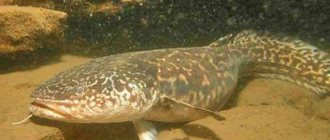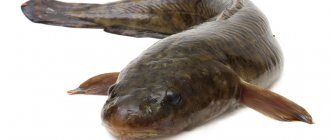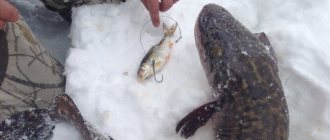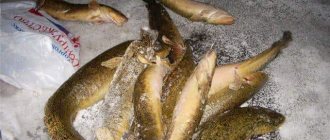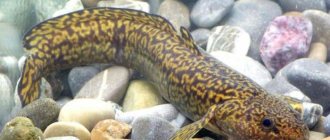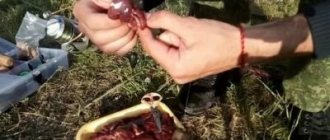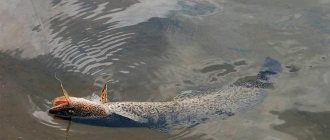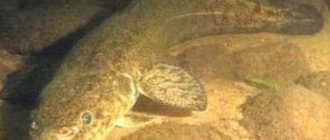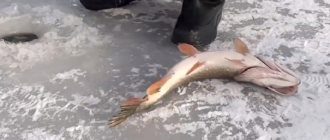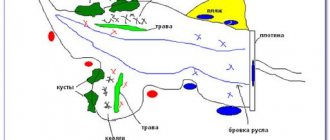Habits of winter burbot
With the onset of freeze-up, the behavior of burbot practically does not change - we can say that its autumn fishing gradually turns into winter. On the fast taiga rivers the riffles gurgle and the banks have barely begun to flow - there they are still fishing for burbot; stagnant bodies of water are covered with ice, on which a fisherman can walk, albeit with caution and crashing. Here they are already supplying burbot. Although, for some other fish, the transition from autumn to winter means a week or two of adaptation to new conditions, which means a temporary cessation of biting. This circumstance does not seem to concern burbot at all, although some of the fish, as if dumbfounded, float up to the ice itself, and remain in this position until its thickness reaches about ten centimeters.
In the old days, people practiced gambling, but at the same time unsafe, catching surfaced burbot using a light and an ax. With flashlights or bundles of splinters, fishermen looked for them standing under the ice, and then knocked them out with a blow from a butt. Then all that remained was to cut the ice and pull out the fish that had turned upside down. By the way, this is how they caught not only burbot, but also pike[1]L. P. Sabaneev, “Life and fishing of freshwater fish.”.
But as soon as the ice gets stronger, all the burbots will certainly wander along the bottom in search of potential prey. And after some time, their pre-spawning migration will begin. River fish will slowly move upstream, lake fish will begin to occupy shallow pebble and rocky areas. All this time they will be consistently caught using winter donks and special burbot spoons.
There are no clear timing of spawning for burbot, only one thing is known - usually this happens when the lowest water temperature is observed, but certainly not in the dead of winter. In temperate latitudes, fish spawn in December-January; in the north this happens earlier, by about a month - from November to December. The largest individuals spawn first, followed by the middle fish, and after that - fish that have barely reached sexual maturity. That is why the whole process is so drawn out in time. Also, spawning has virtually no effect on fishing, because those fish that do not participate in spawning do not stop biting.
After spawning, burbot leaves shallow waters and begins to be found in deeper places, where they continue to be caught until the ice melts.
Cold-loving burbot: a little about the fish
In the rivers of the European basin, burbot is found at depths, near streams at the bottom and near channels.
It is better to catch fish at night when they come out of the holes. Large burbots search for their prey on cool summer nights, also in the dark.
It is found next to a large school of some small individual, for example, if a lot of ruffe live in the same reservoir, then the burbot will feed on it.
In the rivers of Siberia, the clumsy burbot hunts grayling; it succeeds because grayling is not very mobile in the dark.
This fish can be lured by a fire on the shore; the curiosity of the burbot will gather several individuals near the shore. The exception will be moonlit nights.
So, it is caught in the evening and at night. He is very voracious that some fish can devour their fellows while in the cage.
Tackle and bait used for catching burbot in winter
As mentioned above, there are two ways to catch winter burbot - bait and lure. However, there are several types of specific gear that burrowers use.
Zherlitsa
Burbot can be caught quite successfully using traditional flag fishing rods, but I would recommend leaving this gear for pike fishing. The fact is that they are designed taking pike bites into account: a reel with a supply of fishing line is needed to allow the toothy predator to calmly step aside and swallow the bait.
Burbot does not require this - he swallows the bait where he grabbed it. Therefore, a large supply of fishing line on the reel is not needed - only as much as the depth in the fishing spot, plus a maximum of a meter. If there is more, the burbot will pull out the entire line and settle somewhere. And what kind of tricks he will start doing after he has been spotted - you have to see that. Surely all the snags will be there, so it is better to keep the burbot on the hook strictly under the hole.
So what now - rewind the fishing line to a shorter one? This is not the case, especially since on a reservoir or river the depth can vary greatly from place to place. Therefore, it is better not to engage in nonsense, but to use the gear described in the next chapter for targeted burbot fishing. Fortunately, she is the choice of experienced “takers”.
Winter donka
The equipment used for winter burbot donkey is quite simple. For example, this could be an option used in autumn fishing.
Rice. 1. Autumn rig for burbot (main line thickness 0.4-0.5 mm): 1 - fastener for changing the leash (if suddenly the burbot swallows the hook deeply); 2 — swivel; 3 - leash (length 30-40 cm, thickness 0.3 mm, if long time intervals between checks of supplies are expected - it is better to use tungsten); 4 - clasp for changing the hook, in principle it is optional; 5 - hook (in this example, a double is used, threaded under the gill cover of the live bait). We use the sinker according to the fishing conditions; it is better to tie it on a leash that will be a tenth of a millimeter thinner than the main line.
But recently there has been a tendency to use equipment tied on one fishing line in winter.
Rice. 2. Equipment for winter donkey for burbot: 1 - hook (in this version double, but can be single); 2 - leash; 3 - clasp; 4 — swivel; 5 — silicone stopper; 6 - sliding sinker-"olive".
How is this equipment better than the autumn one? I think the point here is in the way the gear is installed and the horizon of its operation. Autumn equipment is designed for casting over a certain distance, so the sinker is located at the end - to reduce the likelihood of getting caught. The leash also branches towards the sinker - so that during the flight it springs slightly and moves the hook away from the main line.
Winter equipment simply goes down into the hole, so nothing like that is required. But at the same time, we can make the fishing horizon minimal - literally put the bait at the very bottom - which is important in burbot fishing. That's why the sinker is right on the line.
However, the equipment in the winter donk is not everything. Its most important element is the reel on which the fishing line is stored. It is a board with a length of at least two diameters of the hole, the width and thickness are chosen arbitrarily - such that the board is strong enough and not too bulky.
A slot is made in the side of the reel so that the distance from it to the ends is equal in both directions. It is advisable to make the slot closer to the central axis of the board, but not so much that it greatly weakens it.
When setting the tackle, the bait is lowered into the hole to the bottom, then the fishing line is inserted into the slot, and the reel is placed across the hole, so that the fishing line coming out of it is clearly in the center of the hole and any attempt to pull it down is useless.
Rice. 3. This is approximately what a winter donka for burbot looks like and is installed.
As you can see, it’s simplicity itself. But at the same time, this tackle is very catchy and reliable.
Winter spinners
To catch burbot in winter, different lures are used: pike, zander, balancers (with the tee removed) and special burbot lures. The latter, of course, are the best, but they can hardly be bought in fishing shops, so fishermen make these baits themselves.
They play with a spoon in virtually the same way as when catching other fish: they wave it rhythmically or shake it lightly, imitating a fry. The main thing is that all pauses are at the bottom.
But the main attracting factor here is not the play of the spinner, but the sound - which collects burbot from the spinner from some distance, so it is sure to be knocked on the bottom.
Now about artisanal baits. As a rule, these are horizontal spinners. They are made in different ways: they are cast from lead, turned on a lathe, a bullet is adapted for this purpose, and even the balance beams are “cut” by sawing off the tail and the lower loop for the tee.
Rice. 4. The simplest jig for burbot, which is quite possible to make at home.
Rice. 5. Balancer, converted to burbot.
However, the bottom at the fishing spot is not always hard, so fishermen had to take the path of improving the spoon and making it noisy. The easiest way is to attach movable elements like petals to it, which will jingle quite nicely. This can be done both before casting - by placing the petals under the wire eye of the spoon frame (it can also be cast on a jig hook), and after - through the winding ring.
But the mercenaries didn’t stop there and invented hollow baits - with metal balls inside. Typically, such “rattles” are made from brass or copper tubes, cartridge cases, or soldered from a thin metal sheet, weighted with lead. The main thing is to ensure that the “rattle” is sealed. What’s interesting is that these baits also catch petals.
Rice. 6. Spinner “rattle” and its structure.
According to fishermen who know a lot about burbot, the best time to catch it with a noisy spoon is before spawning, when fish respond especially well to the sound. There is an assumption that, in this case, the spinner is “interested” in burbot not only as prey, but also as an undesirable creature - a potential caviar eater, which must be urgently gotten rid of.
Photo 7. Imported bait for burbot.
Recently, the foreign fishing industry has begun to produce spoons for catching burbot. An obligatory element of such a bait is a movable hook that knocks and makes some noise, or several miniature petals attached to the lower edge of the bait.
However, as practice has shown, handicraft spoons made by fishermen who know a lot about burbot are still more catchy than industrial ones.
A few words about the fishing rod and fishing line
Any strong fishing rod is suitable for trolling burbot. Often fishermen make it themselves from fiberglass rods.
The line is usually set to 0.3 mm, or even thicker - if there is a chance of catching burbot weighing more than 10 kg.
Features of catching burbot from ice
There is probably no stranger fish than burbot. It differs from most fish in our reservoirs in its completely extraordinary craving for icy water, in which other fish, for example, from the carp family, simply will not survive or will fall into complete suspended animation, almost ceasing vital activity and becoming covered in thick mucus.
The same applies to the timing of burbot spawning. All fish, like fish, spawn in the spring, in warm times, when the water temperature exceeds 12-15 degrees, or even 18-20 degrees Celsius. This same renegade, the burbot, has an urge to reproduce in the most severe frosts of December-January, when life under the ice resembles slow motion and “normal” fish hardly eat, let alone make love and reproduce. Only burbot under the ice is alert and active in the “deafest” time of winter, which gives it a clear advantage over other fish that sleep in wintering pits or barely “move” their fins. In fact, this predator commits robbery, taking advantage of the helpless state of the victims, almost according to the criminal procedure code... The timing of spawning and the best fishing for burbot in the pre-spawning and post-spawning periods may shift slightly and differ in different regions. It all depends on the water temperature and other factors inherent in each specific reservoir and burbot habitat area. In some places, spawning can occur until February, and successful fishing begins in March.
The unusual habits of this nocturnal predator are directly related to its origin. It is directly related to another ice-water lover, the Norwegian cod. Burbot is the only cod fish that has managed to adapt to fresh water, but, nevertheless, has retained its previous habits.
November cannot be called a period of full-fledged burbot fishing from the ice, since in recent years the ice has not been established everywhere even in December. Therefore, many fans of fishing for burbot and its gastronomic qualities often catch the nocturnal predator with donks and zakidushki in November. But in other Russian towns, burbot ice fishing is already in full swing in November.
On small forest rivers with cold water there are quite a lot of burbot. And here it is much easier to find it than, for example, on a reservoir of a large river, where the former habitats of this fish - spawning routes along rivers and streams - are under water. And the burbot simply scattered across the vast territory of the artificial sea, finding refuge, some in snags, some on the edges of pits and flooded river beds. If we talk about the Cheboksary Reservoir, then when there were still groves of flooded forests in the water, it was not difficult to look for burbot communities. Burbot lived right in the flooded forest, on lawns and clearings among dry birches, maples and oaks. Since many fishermen spent the night right on the ice in tents and under awnings near the fire, they could catch burbots on girders near their temporary shelter houses. The only thing that spoiled burbot fishing was the constant snagging and broken gear. This energetic, nocturnal, bottom-dwelling predator had no trouble getting the gear into the snags. Therefore, pike girders had to be shortened from 12-15 meters of fishing line to 3-4 meters, taking into account the depth. This was the minimum free movement, otherwise you would definitely lose the tackle.
When fishing on a small forest river, where burbot are delicious, just as the water of these rivers is tasty and clean, the choice of place for winter fishing is made based on autumn observations and fishing. Somewhere in mid-October or early November, burbot fishing begins with donks and baits. And based on the results of this fishing, the edges and trails of the burbot are determined, where it will feed, most likely, under the ice. If autumn fishing in a certain hole was successful, then on the first ice you can safely place live bait gear here and fish with a fishing rod. Usually, burbot goes hunting in holes after rapids, where weakened small fish roll in and where various aquatic creatures crawl along the bottom. Sometimes the burbot trail runs along the border of a deep hole, where, under a steep bank, lie at the bottom the trunks of bog oak and other driftwood, brought in by high water. This boundary separates the pit dump and the sloping sand spit coming from the low bank. Hunters for autumn burbot usually set up their spots on such spit-beaches. And the hole on the opposite steep bank is both the daytime bedroom of a nocturnal predator and a place for summer resting, when burbots hardly feed and stand in holes near cold springs gushing from the bottom and in such stumpy deep holes, often hidden from the sun by lying in spruce water Here the water temperature is the lowest compared to the river bed and, especially on the rifts and in shallow bays, where this cold-loving predator simply would not survive.
Burbot from forest rivers is very tasty and rich in the ear. But unlike other fish in the fall, it is less valuable from a gastronomic point of view. Somehow, at this time, its liver shrinks, which apparently prepares a place for the caviar. Only the liver of the spring burbot is truly tender, white and fully voluminous, often covering a third of the entire length of the fish. Consisting almost entirely of fish oil, it is nutritious, fatty, tender, but not cloying, as fatty foods are. In short, this is a real fish delicacy, akin to Norwegian cod delicacies.
On the Yenisei and other large rivers of Siberia and the Russian North, giant burbots weighing more than 15 kilograms are found. In central Russia, burbots weighing more than 3 kilograms are rarely caught. But in the reservoirs of Siberia, and in the rivers and reservoirs of the middle zone, the methods of catching burbot from ice are approximately the same, only the sizes of the gear differ, more precisely the thickness of the fishing line, the size of the hooks and the weight of the bait, if we talk about fishing with fishing rods.
Nozzles and refills
Unlike spring or autumn, the choice of baits for catching burbot in winter is not large.
Zywiec
Photo 6. Ruff is the best live bait for catching burbot in winter.
The best option here is a ruff. This fish is consistently caught throughout the freeze-up, and it has also been noticed that burbot prefer it to others.
A good alternative to ruffe is gudgeon, but you can get it in sufficient quantities at the beginning of the season; closer to the middle of winter, the gudgeon’s activity decreases, and it no longer bites so vigorously.
It is highly desirable to use bottom fish as live bait. Many fishermen note that burbot bites better on them.
Usually live bait is harvested during the day - in the same place where they plan to catch burbot. But some fishermen have gotten used to catching it in the fall and keeping it in an aerated container with water, or a cage.
In some regions of Siberia, live bait is considered the only true bait for catching burbot in winter using girders and bottoms.
I strongly recommend following the example of the Siberians and, if possible, fishing with live bait. Practice has shown that among passive gear, live bait is definitely more catchy.
Dead fish
If live bait is prepared in advance and kept in a ditch, then those that have fallen asleep should not be thrown away, but rather frozen (but only if they have not had time to spoil). Subsequently, when fishing, they can be used as a bait for a spinner.
It is also possible to set up girders and donks with dead fish, but it is better to use this practice only if it was not possible to get live bait.
Fish meat
However, a dead fish can be put on a hook not only whole, but also in pieces (according to some reports, burbot is even better suited for cutting). Also, nothing prevents a fisherman from buying the same carp, crucian carp or any other (preferably freshwater) fish in the store and using it for bait.
But fish meat shows itself best as a bait for spinners.
Among some fishermen (and there are quite a few of them) there is an opinion that burbot readily feeds on carrion. However, any bait that the fisherman is going to use must be fresh . Burbot never bites on spoiled fish - this has been repeatedly tested by fishing experience.
Search Locations
In winter, burbot returns to its former places in search of food. The territory chosen in the spring is checked in the fall, and completely controlled in the winter. Mostly these are bottom and near-bottom areas on a river or lake, where ruffs are necessarily found. It is the presence of this small fish in the reservoir that will confirm the guess as to whether this predator lives here.
Experienced fishermen who specialize specifically in catching burbot in rivers advise choosing the following fishing spots:
- river mouth;
- stone ridges;
- stuck holes;
- near trees that have fallen into the water;
- at the border of the current and the whirlpool.
Photo 1. The right choice of place is the key to successful fishing.
In winter, you should wait for lake burbot in places with underground springs or on shallows with a sandy bottom covering.
It is not by chance that burbot chooses such places; as the temperature drops, the inhabitants of water spaces become less active and choose quiet, secluded places for themselves. This is exactly what this representative of cod fish uses.
But promising places are not always the key to successful fishing; sometimes it takes several days to find this fish. But after this the trophy becomes even more attractive.
Towards the end of winter, burbot becomes more active; it is during this period that even a novice fisherman will be lucky with his catch.
Search for fish
But it’s not enough to understand what to fish for burbot and with what. The fisherman must understand where to look for fish at a particular point in time, because choosing the right place is crucial in catching burbot in winter.
Burbot trails
It often happens that out of two fishermen sitting next to each other, only one catches. And sometimes funny things happen.
A resident of one of the villages on the banks of the Sylva River - which is famous for its abundance of burbot - once told a story about how he caught a whole company of spinners. He said: “he clearly sat down above the path.”
Let's figure it out - how do such paths arise?
The burbot's lifestyle and its feeding method determined its physique. It has a massive head and a wide mouth - to fight and cope with fairly large fish. Its dense body is endowed with a capacious womb - to digest large prey, and thanks to its long, ribbon-shaped tail - it crawls deftly and can make short but lightning-fast throws. At the bottom, all this allows him to be one step ahead of other fish, but in the water column and especially in the current, such a “composition” is of little use.
Therefore, burbot does not like rapids and wanders throughout the winter in quiet places, or where the current is weak.
During spawning migration, he has to overcome riffles, and he does this very masterfully: he “feels the stream” - he studies the water currents and finds a place where the strength of the current is minimal. There he forces it.
This usually happens on the side of a riffle, often almost right next to the shore, where there is only a small distance between the ice and the bottom.
It takes strength to overcome the rapids, so the burbots accumulate directly under the riffle, or on the side - there the fish rest for a short time and prepare for the next rush forward. Then they follow the same route, which is determined by the local terrain - this is how the “trail” is formed. Finding it is the fisherman’s first task.
This is done simply. It is enough just to roughly estimate where the boundary of the stream is, and by drilling several holes, find the point at which the spinner stops being carried over the edge of the hole. Also one of the signs here is ice. The thicker it is (hence, the less it is eroded by the current) - the more likely it is that the place will turn out to be promising.
After spawning, the burbot’s stopping places and feeding areas change. Now it makes sense to look for it in depth.
All of the above is relevant only for the night, because during the day the winter burbot, although relatively active (it may well bite), stands still, as a rule - in not too deep places: on the reach (at the end of the hole), or almost under the stream itself - where there is more oxygen.
Locations of burbot at different times of the day
If in open water during the day the burbot not only sits somewhere, waiting until it gets dark, but also does not feed, then in winter there are some deviations from this rule. On a winter day, burbot may well bite. If a fisherman finds his anchorage and slips the bait under the fish’s nose (for which, by the way, Siberians practice a technique called “sniffing” fishing), then he can get himself “snapped” quite well.
However, night fishing will still be more successful than daytime fishing - and not only due to the fact that burbot begins to actively move in the dark, but also due to a noticeable increase in its “appetite”. During the day, burbot can stand for a long time next to the spoon and look at it - before making an attack, or maybe even “change its mind”. At night, he grabs her “without thinking.”
It has also been noticed that before spawning, burbot bite vigorously, but at strictly defined hours, which are confined to the evening and morning twilight, in the middle of the night there is usually no bite. After spawning, this is no longer observed; at this time, burbot, as a rule, bites throughout the dark time of the day.
Let's sum it up
The following picture clearly shows where to look for burbot in different periods of winter and at different times of the day.
Fig. 8. Approximate places for catching burbot on the river in winter. Daytime stops: 1 - under the rift next to the main stream; 2 - at the exit from the pit. Places for night feeding before spawning: 3, 4 - shallow waters. Places of night feeding after spawning: 5 - beginning of the pit, 6 - middle of the pit on the side of the main stream. 7—protrusion of the coastal relief.
As for standing reservoirs, there is no current there, and everything is much simpler. The fisherman should only take into account the depth: before spawning - shallow water, after spawning - other places.
Postavukhi - the simplest and most effective tackle for burbot
Fishing with donkeys is, of course, inferior in sportiness and excitement to fishing for burbot with a fishing rod, but it can be combined with a fishing rod and girders. While the fisherman sits in a tent and entices the burbot with the game of a jig or spinner, the baitfish stand to the side on catchy edges and catch the predator with a “self-hook”, complementing the angler’s night catch of this tasty fish.
The tackle is very simple and consists of just a piece of fishing line, a sinker and a leash with a hook tied above the sinker. A stick is placed across the hole, to which the fishing line is tied. The main supply of fishing line is on the reel. You just need to lay about two meters of free fishing line next to the hole so that the burbot, having taken the bait, does not immediately prick itself on the hook without having time to swallow the ruff or worm.
If the weather is frosty, then the supply of fishing line can be tucked under the ice. The current will take up the slack from the excess fishing line, but, nevertheless, these two meters of fishing line will maintain free movement for the predator. In places without a current, the line will simply hang freely in the water column. Burbot does not require sensitive gear. The thickness of the fishing line and the size of the hook are selected according to the fishing conditions in a given place. For example, on a small forest river, the main fishing line for the hook is 0.5 mm, and the thickness of the monofilament leash is 0.3-0.35 mm. The hook can be placed in a large single hook No. 10 of our numbering. This is for planting a tassel of worms. And for “cutting” or live bait it is better to use a double no. 8-8.5. The weight of the sinker depends on the strength of the current in a given place, but on average it is 100-120 grams. On the Volga, the sinker may be larger depending on whether you are fishing on a riverbed or on a reservoir without a current.
Postavukhas do not have a bite alarm and are simply checked by the fisherman from time to time. These gears are often caught by both fishing rods and girders, despite their primitive simplicity.
Search for points and fishing spots
As we have already said, to successfully catch burbot, you need to find its trails and stopping places. Burbot loves a rocky, pebble-sandy bottom with shelter. It often stands in holes, next to which there are strandings. Large stones at the bottom, sandy or stone slopes, mouths of rivers and streams, holes under a steep bank attract it. It can live in its favorite place for years, and it is important for the fisherman to find this point.
Places to search on the river
Trails are the routes by which burbot travel to hunt at night. These routes leave the parking point, pass through places interesting for burbot and return again to the habitat of the predator. The trails can be several hundred meters long; burbot travels around them once at night.
And if a fisherman finds a path, he should not stop, but continue searching: after all, this means that somewhere nearby there is a parking lot that can house a huge number of these fish.
Choosing the right jig
You can find burbot jigs on sale. It is important to pay attention to the hook - on store-bought baits it is usually small and weak. It is best to buy jigs made of non-ferrous metals, bronze or brass; they are the ones that sound better at the bottom when hitting rocks. You can start with lead cones, which are easy to find in any fishing store or you can make yourself. A standard jig head is also suitable as a jig for burbot in winter. The weight is selected depending on the current and the size of the expected trophies. It is better to use a medium-sized jig with a relatively large hook. Experienced anglers note that a white jig head works better. Burbot are attracted by the faint glow from the phosphorus eyes on the jig head; these can also be found on sale.
Lead cones
Homemade Mormobles
Homemade cones
White painted summer jig head
You can often find so-called jig jigs. These jigs are called that because they have the size and weight of a really small jig head. Such baits are also very good for catching burbot by tapping.
Jig jig
The best option is super-heavy hand-made bronze jigs. Such baits can be found online from craftsmen who do this.
Handmade bronze bait
Subscribe to the channel:
My YouTube channel RYBAFAN on fishing:
We're OK
Where is burbot found?
Burbot hides in deep water in crevices and depressions. Experienced fishermen advise choosing places close to shores and beaches, but it is imperative that there are sharp rapids where shallow water abruptly turns into depth.
Headlands and bends are other spots where burbot can live. In order to catch fish, you should install several gears (jars) in those places where burbot can definitely be found. Everything should be done carefully. The ideal depth to which the gear should be lowered is 7-15 meters. In order to correctly determine the depth, many fishermen use an echo sounder.

